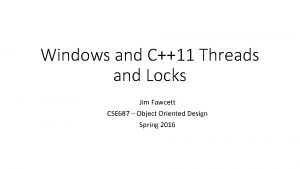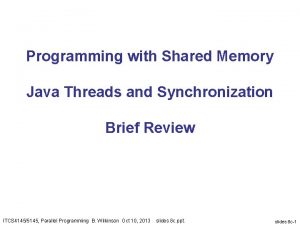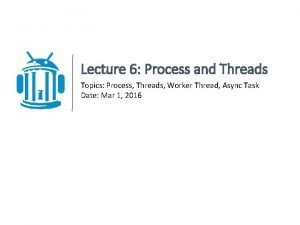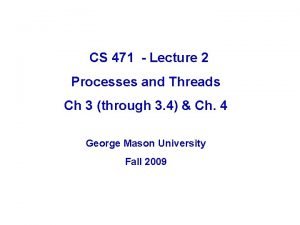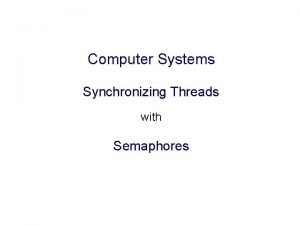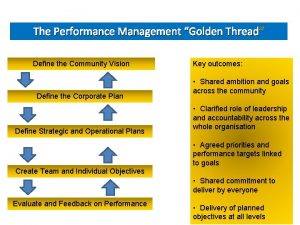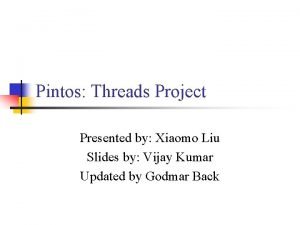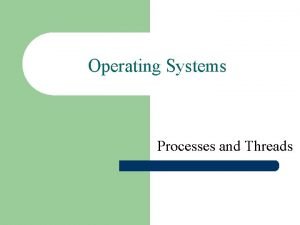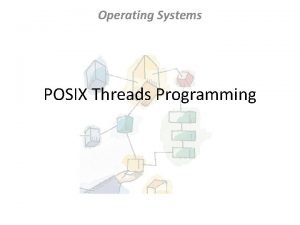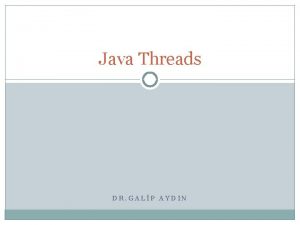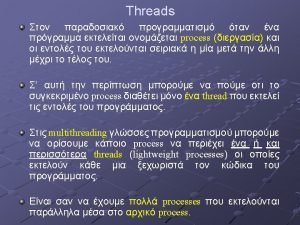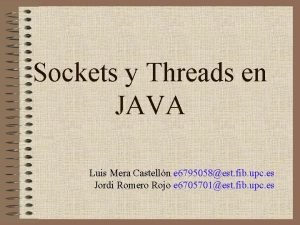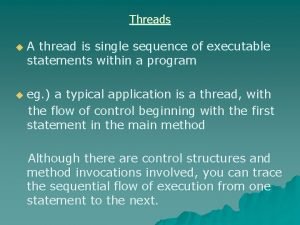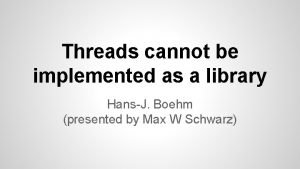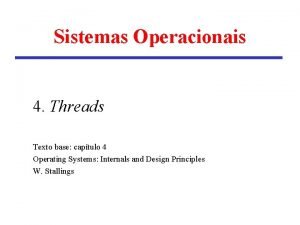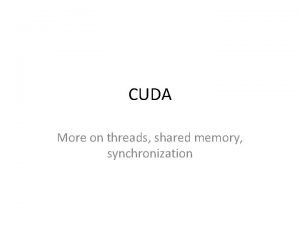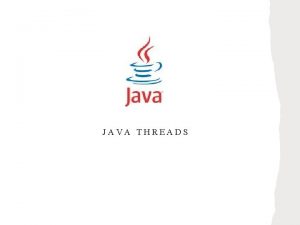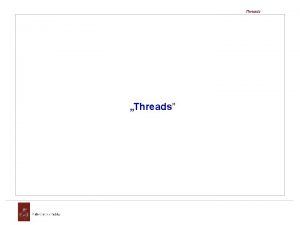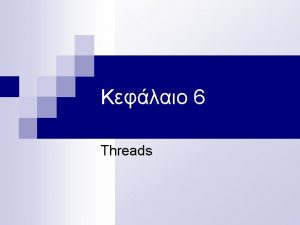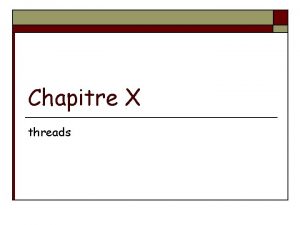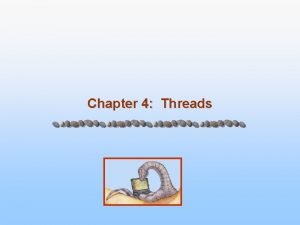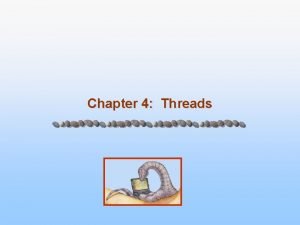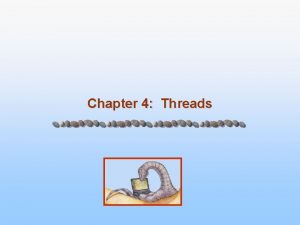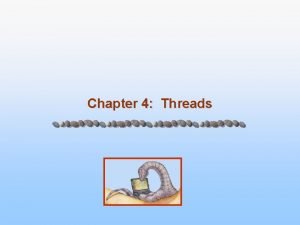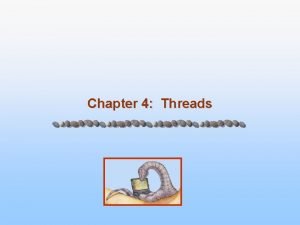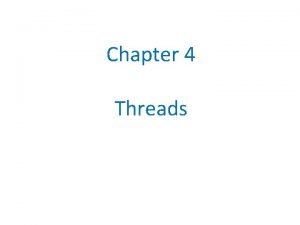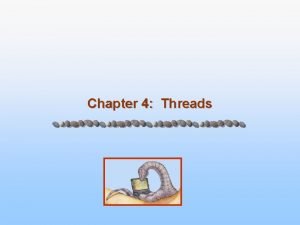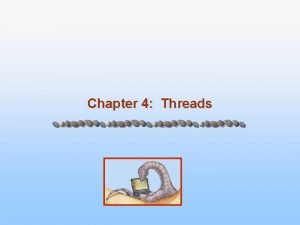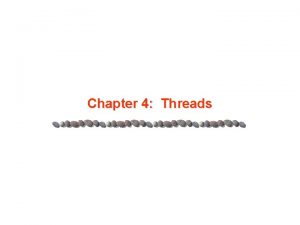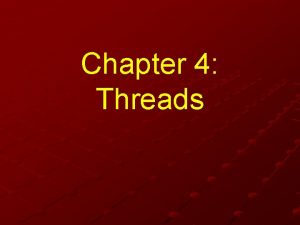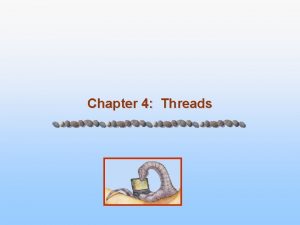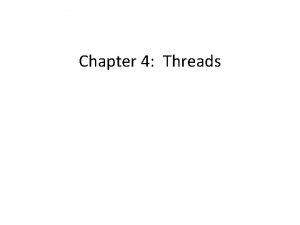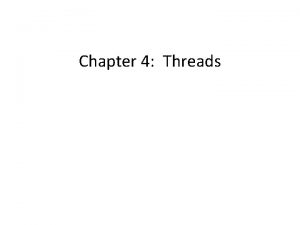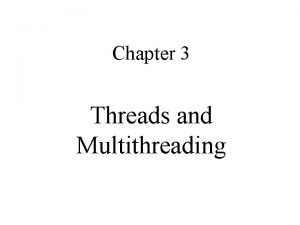Chapter 4 Threads Chapter 4 Threads n Overview




























- Slides: 28

Chapter 4: Threads

Chapter 4: Threads n Overview n Multithreading Models n Threading Issues n Pthreads n Windows XP Threads n Linux Threads n Java Threads 4. 2

Single and Multithreaded Processes 4. 3

Benefits n Responsiveness n Resource Sharing n Economy n Utilization of MP Architectures 4. 4

User Threads n Thread management done by user-level threads library n Three primary thread libraries: l POSIX Pthreads l Win 32 threads l Java threads 4. 5

Kernel Threads n Supported by the Kernel n Examples l Windows XP/2000 l Solaris l Linux l Tru 64 UNIX l Mac OS X 4. 6

Multithreading Models n Many-to-One n One-to-One n Many-to-Many 4. 7

Many-to-One n Many user-level threads mapped to single kernel thread n Examples: l Solaris Green Threads l GNU Portable Threads 4. 8

Many-to-One Model 4. 9

One-to-One n Each user-level thread maps to kernel thread n Examples l Windows NT/XP/2000 l Linux l Solaris 9 and later 4. 10

One-to-one Model 4. 11

Many-to-Many Model n Allows many user level threads to be mapped to many kernel threads n Allows the operating system to create a sufficient number of kernel threads n Solaris prior to version 9 n Windows NT/2000 with the Thread. Fiber package 4. 12

Many-to-Many Model 4. 13

Two-level Model n Similar to M: M, except that it allows a user thread to be bound to kernel thread n Examples l IRIX l HP-UX l Tru 64 UNIX l Solaris 8 and earlier 4. 14

Two-level Model 4. 15

Threading Issues n Semantics of fork() and exec() system calls n Thread cancellation n Signal handling n Thread pools n Thread specific data n Scheduler activations 4. 16

Semantics of fork() and exec() n Does fork() duplicate only the calling thread or all threads? 4. 17

Thread Cancellation n Terminating a thread before it has finished n Two general approaches: l Asynchronous cancellation terminates the target thread immediately l Deferred cancellation allows the target thread to periodically check if it should be cancelled 4. 18

Signal Handling n Signals are used in UNIX systems to notify a process that a particular event has occurred n A signal handler is used to process signals n 1. Signal is generated by particular event 2. Signal is delivered to a process 3. Signal is handled Options: l Deliver the signal to the thread to which the signal applies l Deliver the signal to every thread in the process l Deliver the signal to certain threads in the process l Assign a specific threa to receive all signals for the process 4. 19

Thread Pools n Create a number of threads in a pool where they await work n Advantages: l Usually slightly faster to service a request with an existing thread than create a new thread l Allows the number of threads in the application(s) to be bound to the size of the pool 4. 20

Thread Specific Data n Allows each thread to have its own copy of data n Useful when you do not have control over the thread creation process (i. e. , when using a thread pool) 4. 21

Scheduler Activations n Both M: M and Two-level models require communication to maintain the appropriate number of kernel threads allocated to the application n Scheduler activations provide upcalls - a communication mechanism from the kernel to the thread library n This communication allows an application to maintain the correct number kernel threads 4. 22

Pthreads n A POSIX standard (IEEE 1003. 1 c) API for thread creation and synchronization n API specifies behavior of the thread library, implementation is up to development of the library n Common in UNIX operating systems (Solaris, Linux, Mac OS X) 4. 23

Windows XP Threads n Implements the one-to-one mapping n Each thread contains l A thread id l Register set l Separate user and kernel stacks l Private data storage area n The register set, stacks, and private storage area are known as the context of the threads n The primary data structures of a thread include: l ETHREAD (executive thread block) l KTHREAD (kernel thread block) l TEB (thread environment block) 4. 24

Linux Threads n Linux refers to them as tasks rather than threads n Thread creation is done through clone() system call n clone() allows a child task to share the address space of the parent task (process) 4. 25

Java Threads n Java threads are managed by the JVM n Java threads may be created by: l Extending Thread class l Implementing the Runnable interface 4. 26

Java Thread States 4. 27

End of Chapter 4
 C11 threads
C11 threads Shared memory in java
Shared memory in java Screw thread profile adopted by bis
Screw thread profile adopted by bis Process and threads
Process and threads Flexible flat material made by interlacing yarns
Flexible flat material made by interlacing yarns Escalonamento de threads
Escalonamento de threads Process and threads
Process and threads Os threads
Os threads The vinaya pitaka is a sacred text of
The vinaya pitaka is a sacred text of Needle like threads of spongy bone
Needle like threads of spongy bone Heavy duty cutting of fabric
Heavy duty cutting of fabric Threads performance management
Threads performance management Priority donation pintos
Priority donation pintos Slidetodoc.com
Slidetodoc.com Posix threads in os
Posix threads in os Threads java
Threads java Osteospermum white lightning
Osteospermum white lightning Forum.unity.com/threads/game-over.54735
Forum.unity.com/threads/game-over.54735 /threads/ fiji
/threads/ fiji Threads consume cpu in best possible manner
Threads consume cpu in best possible manner Sockets and threads
Sockets and threads Posix threads
Posix threads Forum.unity.com/threads/game-over.54735
Forum.unity.com/threads/game-over.54735 Process thread
Process thread Sequence diagram threads
Sequence diagram threads Threads cannot be implemented as a library
Threads cannot be implemented as a library Threads.h
Threads.h In centreless grinding workpiece is supported by mcq
In centreless grinding workpiece is supported by mcq Cuda threads per block
Cuda threads per block
